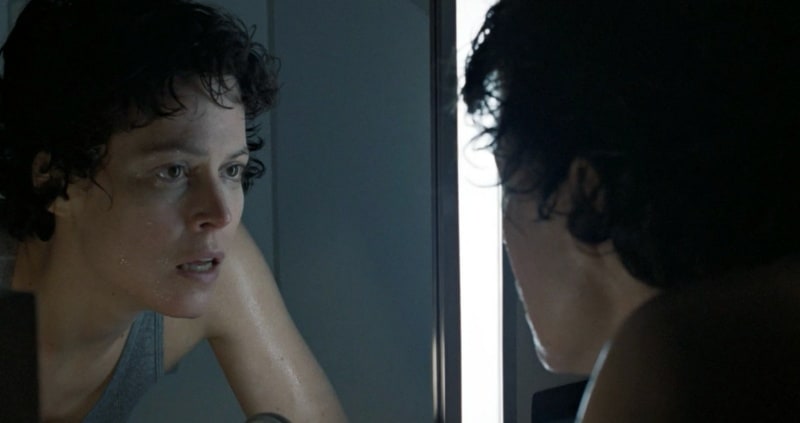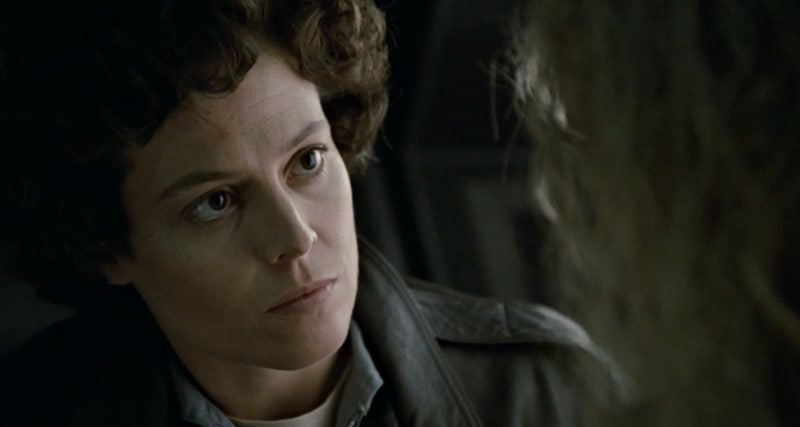Acting is an art form, and behind every iconic character is an artist expressing themselves. Welcome to The Great Performances, a bi-weekly column exploring the art behind some of cinema’s best roles. In this entry, we examine Sigourney Weaver’s Academy Award-nominated performance as Ellen Ripley in Aliens.
The blockbuster action movies of the 1980s were built on excess, best personified in a moment in the Arnold Schwarzenegger hit Commando (1985). When his character, John Matrix, prepares to storm the island compound of an ex-South American dictator, there is a prolonged suit-up scene where he slings gun after gun over his shoulders, loading up his chest with enough grenades and ammo to take down the small army he’s about to face. It plays more like visual hype-up music, getting the audience stoked for the ensuing battle, rather than a moment for the audience to see Arnie’s commando mentally and emotionally preparing himself for a fight that could cost him his life.
One of the most common criticisms lodged at action movies, especially from that decade, is that they lack any real emotional substance. This complaint isn’t always unwarranted. While the core themes of the Rambo franchise concern the post-traumatic stress of Vietnam War veterans, the sequels eschew the nuances of the original film for over-the-top action set pieces. And while those sequences are exhilarating, they’re missing the emotional engagement we first feel for Sylvester Stallone’s character in First Blood (1982).
The same can’t be said for Sigourney Weaver in James Cameron’s Aliens (1986). Weaver’s Ellen Ripley also packs an impressive amount of heat during her suit-up scene as she descends into the belly of a processing station to face off against the Xenomorph Queen. But the moment before the elevator doors open, we see her reckon with the showdown she’s about to have. As she blinks tightly, her eyes resting a beat, she opens them again with this piercing stare filled with mournful determination. We see her come to terms with the fact that this fight could be her last. This added element of emotional nuance that Weaver gives Ripley grounds the character in reality. She seems more like an actual person instead of some indestructible action figure like John Matrix.
Pop culture has rightfully placed Weaver’s Ripley shoulder to shoulder with the other great, and mostly male, action heroes of the 1980s. She, however, smartly resists making her character just another unstoppable killing machine. Ripley may brandish grenade launchers and flamethrowers throughout Aliens, but the hardware she handles isn’t what makes Weaver shine. It’s the grueling emotional journey she goes through that makes her moments of triumphant action so impactful.

Aliens picks up right where the first Alien (1979) leaves off, with Ellen Ripley floating in hyper-sleep in an escape shuttle from the destroyed Nostromo. After being picked up by a salvage crew and brought to the offices of Weyland-Yutani, the evil corporation at the heart of the franchise, Ripley learns that she has been lost in space for the last fifty-seven years. Everyone she once knew is now dead, including her daughter, Amanda. The shock of this revelation, and the trauma she carries over from the first movie, is what provides the foundation for Weaver to build Ripley’s emotional character arc throughout Aliens.
Famously, Ripley was intended to be a male character in Alien before producer Alan Ladd Jr. suggested casting a woman as their reluctant hero. Because of this, I find the Ripley we meet in the original Alien doesn’t fully encompass the experience of a female character existing in this overwhelmingly masculine world. That’s why the opening scenes of Aliens are so integral to Weaver’s second appearance as Ripley. They allow her character to directly address an issue that the women of this future still face: no one listens to them.
As Weaver’s Ripley speaks to the Weyland-Yutani board of directors about what happened aboard the Nostromo, they dismiss her story out of hand, calling into question not only her ethics but her sanity. Even after they’ve lost contact with the terraforming colony on LV-426, and Ripley is asked to provide her expertise on Xenomorphs, no one listens to her advice. The more she’s ignored, the more Weaver imbues Ripley with justifiable rage that the audience begins to feel as well. We know exactly what Ripley went through in the original Alien, so our blood boils watching our hero be undermined from scene to scene. The constant silencing of Ripley is an aspect of Aliens that would deeply resonate with female audiences who uniquely understand how their voices are often suppressed in patriarchal spaces, like corporate boardrooms or elite military squads.
Another way audiences can read Weaver’s emotional character arc through the film is as a woman struggling with the loss of a child. In the original cut of Aliens, the scene where we learn that Ripley has a daughter is excised, allowing the film to jump straight to the big action set pieces. But in doing so it obscures the reasons why Ripley has an instant connection to the character Newt. In the theatrical cut of the film, you can read their relationship as another example of a female character being relegated to a maternal stereotype. With the inclusion of Amanda, however, Ripley’s motivations become crystallized. We see the care Weaver’s Ripley has for Newt as coming from a place motivated by her backstory, not some misogynistic view of what female characters can or cannot be.

What makes this work so well is how Weaver plays these scenes that ask her to take on a more motherly role. As she wipes Newt’s face clean after they rescue her from a ventilation shaft, the dialogue is written in a way that is arguably intended to soften her character as she tries to comfort this hollowed-out orphan. But Weaver smartly avoids dipping into sentimentality, using her character’s steeliness to provide an interesting contrast to what’s written. Ripley tells Newt in a monotone voice, “Uh oh. I made a clean spot here. Now I’ve done it. Guess I’ll have to do the whole thing.” This is free of any stereotypical maternal sympathy because, as Weaver points out in an interview with Entertainment Weekly, Ripley simply doesn’t have time for that:
“So many people in the business would have said, ‘Well now we have to make her more sympathetic.’ And then it’s suddenly this token scene that shows we’re actually feminine after all, and that’s frankly bulls—, because that doesn’t happen in real life. Ripley doesn’t have time to try to be sympathetic, you know? If she’s still a relevant character, I think it’s because I didn’t have any of that dragging me down.”
With Aliens, Sigourney Weaver side-stepped reductive stereotypes to build a character that has paved the way for a cadre of female action roles, from Charlize Theron’s Furiosa in Mad Max: Fury Road to Jennifer Lawrence’s Katniss Everdeen in The Hunger Games series. The power of Weaver’s performance wasn’t something recognized in retrospect but was noticed immediately upon release. She nabbed nominations from the Saturn Awards, the Golden Globes, and the Academy Awards, the first time ever the Oscars honored an actress for an action movie performance.
The Academy is known for routinely overlooking genre pictures when honoring the best acting performances of the year, so it was a surprise that Weaver’s work was singled out in 1986. But it shouldn’t have been unexpected. Weaver’s performance as Ripley is as thrilling as any blockbuster action hero of the 1980s, and she is able to separate herself from the Stallones and Schwarzeneggers of the world by giving her character emotional nuance. It’s an action performance unlike anything we’d seen before.
In Aliens, Sigourney Weaver’s Ellen Ripley isn’t a stereotypical archetype or some invincible force. She is a regular person thrust into extraordinary circumstances. This quality has helped the character remain iconic, and relatable, more than thirty years later.


0 comments:
Post a Comment